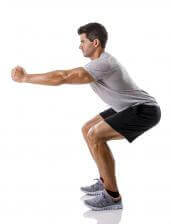4 Ways to Get Stronger Faster
Discover exactly which method of weight training is best for fast results. Plus, Get-Fit Guy has 12 variations of popular exercises to help you get stronger and build muscle faster.
Ben Greenfield
Listen
4 Ways to Get Stronger Faster

A) Do the same exercises in your weight training routine over and over again each week, while gradually increasing the load and intensity…
or
B) Change up your exercises each week so that you’re attacking your muscles from different angles and with new moves.
In this episode, you’re going to discover exactly which method is best and get 4 ways to get stronger and to build muscle faster using some of the top strength gaining and muscle building exercises out there.
What Kind of Exercise Gets You Stronger Faster?
A recent study investigated the effects of methods A versus B (that is, increasing the load versus varying the exercises). The study compared 4 different strength training schemes:
-
constant intensity and constant exercise (CICE)
-
constant intensity and varied exercise (CIVE)
-
varied intensity and constant exercise (VICE)
-
varied intensity and varied exercise (VIVE)
Each group in the study performed twice weekly training for 12 weeks. You can read the study for the nitty-gritty details, but in the end the ultimate finding in the research was this:
CIVE (constant intensity and varied exercise) is the most efficient way to produce strength gains for physically active individuals as long as the training intensity is hard enough to make the muscle fatigued by the end of the set. But actual muscle hypertrophy (or growth) is similar regardless of the training intensity and exercise variation.
So for the ultimate combination of strength gaining and muscle building, you should vary your exercises each week and perform them at an intensity that allows your muscles to reach fatigue by the end of each set. Now that you know what the research says, it’s time to learn variations of 4 fantastic exercises so that you’re not doing the same exercises over and over again when you work out.
Back Squat

When it comes to back squats, people often lack the proper ankle and hip mobility for optimal form. They also often lack proper tension in the upper back and the breathing technique necessary to maintain form and tension throughout the lift.
Doing back squats correctly will get you truly strong. Check out my episode Are Squats Safe for instructions on exactly how to do them. Once you master the basics, here are 3 variations:
-
Variation 1: Barbell Lunges. This variation provides the posterior chain muscles (aka, your butt) the benefits of a back squat while also adding a single leg component. Simply start with a barbell on your back, then do a forward lunge or a reverse lunge.
-
Variation 2: Front Squat. This lift most closely resembles the back squat. Cross your arms over a barbell or set the barbell over your collarbones in what’s called a front rack position. Squatting to full depth and keeping your chest up will provide a whole new challenge for your quads, abs, back (and willpower!)
-
Variation 3: Overhead Squat. Even athletes will be surprised by how much this lift tests them, challenging ankle, hip, and shoulder mobility, while maintaining core stability with a weight overhead.
Deadlift
The basic version of the deadlift goes like this: Pick the bar off the ground while keeping the bar close to your shins and thighs throughout the lift. Keep your chest up, look forward, maintain a neutral spine, and exhale while lifting the bar up overhead.
Here are 3 additional variations:
-
Variation 1: Dead Walks. Start with your feet in a staggered stance and slowly lower your torso to the sides of your lead foot as if you’re doing a regular deadlift, step your back foot up to the lead foot as you raise your torso the same way as you lowered. So it’s almost as though you’re doing a slow, staggered walk with the weight.
-
Variation 2: Tempo Goblet Squats. Even though this is a squatting movement, this will boost your deadlift by challenging the muscles around your spine, especially if you hold the bottom of the squat long enough. Grab a light weight and hold it in front of your chest. Perform a regular squat, holding the weight at chest height and include a 15-second pause at the bottom of the squat before standing back up.
-
Variation 3: Deficit Deadlift. Perform a deadlift off of a deficit, which means that you stand on a raised surface (a step bench or stacked weight plates works fine). Make sure your starting position is good by dropping your butt. Emphasize keeping your chest up, a straight back, and deep breathing.
Overhead Press
In a basic overhead press, you stand with the bar in the front rack position and close to your shoulders, then breathe out as you push the bar up.

Here are 3 variations:
-
Variation 1: Push Press. This lift is very similar to the basic barbell overhead press except it involves your hips. With the bar in the front rack position, lower your body with a slight bend in the knees, and then explode up as you press the bar overhead.
-
Variation 2: Smith Machine Half-Rep Presses. Place a Smith machine at the “sticking point” of your overhead press (about halfway through movement), stand under the bar, perform overhead presses through just half your normal range-of-motion.
-
Variation 3: Waiter Walks. Grab one dumbbell and press it into the locked out position. Make sure you keep a straight back, and press your elbows up to the ceiling with your shoulders should be next to your ears. Then, with the weight overhead, walk the length of the gym or space you’re exercising in for 30-60 seconds with each arm.
Pull-Up
Pull-ups come in two basic varieties: supinated grip or pronated grip (meaning you grip your hands under or over the bar, respectively). Once your grip is established, pull your chin over the bar and lower to a lockout position at the bottom.
Here are 3 additional options:
-
Variation 1: Wide-Grip Lat Pull-Downs. With a pronated grip (that’s hands over the bar), perform a cable lat pulldown while focusing on the lowering portion and a full contraction of your upper back.
-
Variation 2: Pendlay Row. With a loaded bar, grab the bar with the same grip as you’d use to deadlift. Bend at your waist and keep a flat, tight back, then pull the bar up with your elbows pulling close at your sides, followed by lowering the bar to the ground .
-
Variation 3: One-and-a-Half Pull-Ups. Perform one repetition of a regular pull-up, followed by one where you only lower halfway, and then raise up to the top. Perform the full rep, half-rep pattern for your entire set.

Complete each exercise back-to-back as a circuit and do the circuit 3-5 times through or do 3-5 sets of each exercise before moving on to the next exercise, using 60-90-second rest between each set if you choose the latter option.
Do you have more questions about how to gain muscle faster or how to vary your exercises? Have you found one way that works better for you? Share your experiences with us at Facebook.com/GetFitGuy!

